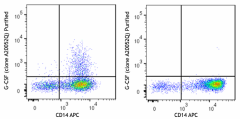- Clone
- A20052Q (See other available formats)
- Regulatory Status
- RUO
- Other Names
- Granulocyte-Colony Stimulating Factor, CSF3, CSF-β
- Isotype
- Rat IgG2a, κ
- Ave. Rating
- Submit a Review
- Product Citations
- publications

-

LPS-stimulated (O/N, left) human peripheral blood mononuclear cells (in the presence of monensin) or unstimulated human peripheral blood mononuclear cells (right) were fixed and permeabilized with Cyto-Fast™ Fix/Perm Buffer (Cat. No. 426803) and then intracellularly stained with purified anti-human G-CSF (clone A20052Q) followed by PE anti-rat IgG. The cells were stained with anti-human CD14 APC. Data shown was from gated monocyte population.
| Cat # | Size | Price | Quantity Check Availability | Save | ||
|---|---|---|---|---|---|---|
| 387602 | 100 µg | 308€ | ||||
Human G-CSF was cloned from a human squamous carcinoma cell line and is the key hematopoietic cytokine involved in the control of neutrophil production. Therefore, it is a critical regulator of innate immunity against bacterial infections. G-CSF mobilizes stem cells indirectly by downregulating the expression of CXCL12 on marrow osteoblasts and by releasing neutrophil and monocyte proteolytic enzymes, including neutrophil elastase, cathepsin G, and matrix metalloproteinase-9, which in turn degrades important HSC trafficking and adhesion molecules c-kit, VCAM-1, and CXCR4. In addition, G-CSF possesses immunosuppressive effects on monocytes/macrophages, dendritic cells, and T lymphocytes. The receptor for G-CSF is expressed not only in hematopoietic cells; it is also expressed in cardiomyocytes, skeletal muscle, and neurons. G-CSF influences mouse skeletal muscle development and regeneration by stimulating myoblast proliferation. In vitro, G-CSF displays strong antiapoptotic activity in neuronal cells.
Product DetailsProduct Details
- Verified Reactivity
- Human
- Antibody Type
- Monoclonal
- Host Species
- Rat
- Immunogen
- Recombinant Human G-CSF
- Formulation
- Phosphate-buffered solution, pH 7.2, containing 0.09% sodium azide
- Preparation
- The antibody was purified by affinity chromatography.
- Concentration
- 0.5 mg/mL
- Storage & Handling
- The antibody solution should be stored undiluted between 2°C and 8°C.
- Application
-
ICFC - Quality tested
- Recommended Usage
-
Each lot of this antibody is quality control tested by intracellular immunofluorescent staining with flow cytometric analysis. For flow cytometric staining, the suggested use of this reagent is ≤ 0.25 µg per million cells in 100 µL volume. It is recommended that the reagent be titrated for optimal performance for each application.
- Application Notes
-
Clones A20052D and A20052Q do not block each other.
- RRID
-
AB_2941576 (BioLegend Cat. No. 387602)
Antigen Details
- Structure
- Heterodimer
- Distribution
-
Macrophages, monocytes, neutrophils, fibroblasts, endothelial cells, epithelial cells, and bone marrow stromal cells
- Function
- G-CSF acts on myeloid progenitor cells to stimulate survival, proliferation, and neutrophilic maturation; on mature neutrophils, G-CSF enhances survival, superoxido anion and alkaline phosphatase production, arachidonic acid release, and antibody dependent cellular cytotoxicity.
- Interaction
- Myeloid progenitor cells
- Ligand/Receptor
- CD114 (G-CSFR)
- Molecular Family
- Cytokines/Chemokines
- Antigen References
-
- Nagata S, et al. 1986. Nature. 319:415-8.
- Kim HK, et al. 2006. Blood. 108:812-20.
- Donahue RE, et al. 2009. Blood. 114:2530-41.
- Shimoji K, et al. 2010. Cell Stem Cell. 6:227-37.
- Martins A, et al. 2010. IUBMB Life. 62:611-7.
- Hara M, et al. 2011. J Exp Med. 208:715-27.
- Gene ID
- 1441 View all products for this Gene ID
- UniProt
- View information about G-CSF on UniProt.org
Related Pages & Pathways
Pages
Related FAQs
Other Formats
View All G-CSF Reagents Request Custom Conjugation| Description | Clone | Applications |
|---|---|---|
| PE anti-human G-CSF | A20052Q | ICFC |
| Purified anti-human G-CSF | A20052Q | ICFC |
Compare Data Across All Formats
This data display is provided for general comparisons between formats.
Your actual data may vary due to variations in samples, target cells, instruments and their settings, staining conditions, and other factors.
If you need assistance with selecting the best format contact our expert technical support team.
-
PE anti-human G-CSF

LPS-stimulated (O/N, left) human peripheral blood mononuclea... -
Purified anti-human G-CSF

LPS-stimulated (O/N, left) human peripheral blood mononuclea...
 Login / Register
Login / Register 







Follow Us